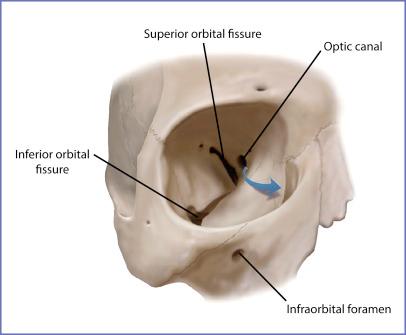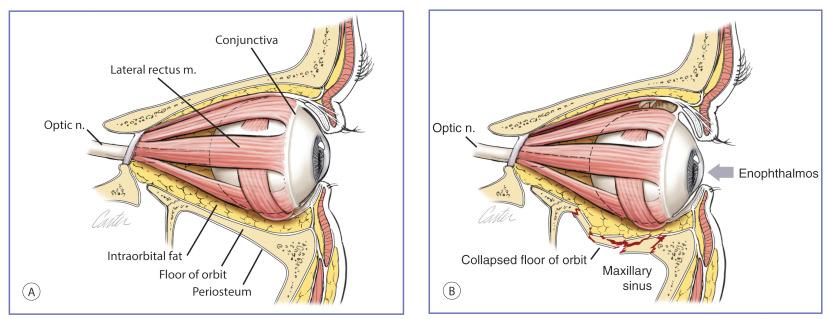Physical Address
304 North Cardinal St.
Dorchester Center, MA 02124
The size and shape of the internal orbit determines orbital volume and the position of the eye. An increase in orbital volume results in enophthalmos – the recession of the ocular globe within the bony orbit. The principal mechanism in its development is the displacement of a relatively constant volume of orbital soft tissue into an enlarged bony orbit. Posttraumatic fat atrophy and scar contracture are real, but less important, factors in causing a mismatch of soft tissue and orbital volume. Recession of the globe changes the drape of the upper lid on the globe, tending to deepen the superior tarsal fold and cause a lowering or pseudoptosis of the upper lid ( Fig. 7.1 ). Two to three millimeters of enophthalmos is clinically detectable, and more than 5 mm is disfiguring.
Enophthalmos may result from fractures involving only the orbital floor or medial orbital wall. These are termed “pure blowout” fractures. More often, enophthalmos is part of an orbital deformity whereby not only the internal orbit is disrupted, but also the adjacent facial skeleton. The internal orbit disruption is referred to as an “impure blowout” fracture in these situations.
Because posttraumatic enophthalmos is primarily due to damage of the internal orbit, the treatment strategy for restoring eye position is anatomic skeletal reconstruction. This is best accomplished by defining the location and extent of injury preoperatively with computed tomographic (CT) scans, widely exposing the injured area, retrieving displaced orbital soft tissues, and replacing the invariably comminuted fractured skeleton.
The internal orbit may be conceptualized as a modified pyramid with an apex, a base, and four walls. The optic foramen, which transmits the optic nerve and the ophthalmic artery, forms the apex of the pyramid. It is located at the farthest superior medial portion of the internal orbit. The base of the pyramid is formed by the orbital rims. The roof, floor, medial wall, and lateral wall constitute the pyramid’s walls. While the entire lateral wall consists of thick bone created by the articulation of the greater wing of the sphenoid and the orbital process of the zygoma, the floor, medial wall, and roof vary in their thickness. They can be divided into concentric thirds based on bone thickness. The anterior third of the internal orbit consists of increasingly thicker bone as it merges with the orbital rim. The posterior third also consists of thick bone with relatively flat walls. The middle third consists of thin bone and allows this portion of the orbit to act as a crush zone, thereby protecting the optic nerve and globe by absorbing impact forces. The floor medial to the infraorbital canal and the inferior portion of the medial wall is typically involved in the “blowout” fracture. This area has a convex shape that produces a constriction behind the globe ( Fig. 7.2 ). Loss of this convexity transforms the internal orbit shape from pyramidal to spherical, increasing orbital volume and tending towards enophthalmos ( Fig. 7.3 ). Certain injuries, usually involving the lateral orbital wall or roof, may result in inward displacement of larger fracture segments. These “blow-in” fractures decrease orbital volume, resulting in globe proptosis.


There are nine openings within each orbit. Most important are the optic foramen, and the superior and the inferior orbital fissures. The optic foramen, located at the apex, transmits the optic nerve. The superior orbital fissure, located between the roof and the lateral wall near the apex, transmits the oculomotor, the trochlear, the ophthalmic division of the trigeminal, and the abducent nerves. The inferior orbital fissure separates the lateral wall from the floor. Through this fissure the orbit communicates with the temporal, infratemporal, and pterygopalatine fossae. It transmits the maxillary nerve, its zygomatic branch, and the ascending branches from its sphenopalatine branch. It also transmits the infraorbital vessels and the vein that connects the inferior ophthalmic vein with the pterygoid venous plexus. The supraorbital foramen, infraorbital canal, anterior and posterior ethmoidal foramina, and zygomatic foramen transmit their respective neurovascular structures. There is also a canal for the nasolacrimal duct.
The clinical diagnosis of significant internal orbital disruption is based on globe malposition. In the uninjured state, the cornea extends approximately 16 to 17 mm anterior to the lateral orbital rim. Immediately after injury, however, globe position may appear normal or proptotic, owing to soft tissue swelling. Without significant edema, a difference in globe position is most easily determined by viewing the globe from the worm’s eye. On frontal view, a deepening of the supratarsal sulcus and a lowering of the upper lid margin (pseudoptosis) reflects an increase in orbital volume and subsequent recession of the globe ( Fig. 7.1 ). When the lateral orbital rim is intact (isolated floor or medial wall blowout fractures), the severity of enophthalmos can be determined with a Hertel exophthalmometer, which measures the difference between the anterior corneal surface and the lateral orbital rim.
Become a Clinical Tree membership for Full access and enjoy Unlimited articles
If you are a member. Log in here